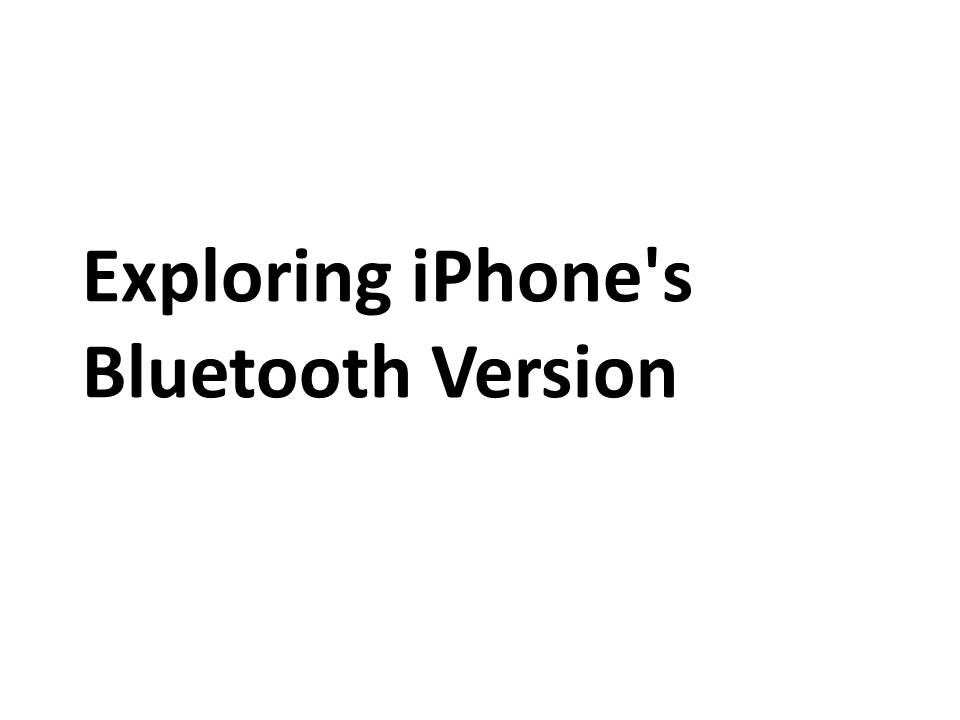Encountering Bluetooth issues on your iPhone? This guide has you covered. Learn how to troubleshoot and resolve common Bluetooth problems, ensuring a seamless connection experience and maximizing the potential of your device.
Exploring iPhone’s Bluetooth Version
1. Introduction
1.1.Bluetooth technology is a wireless communication protocol that facilitates data exchange between devices over short distances. Originally developed as a cable replacement solution, Bluetooth has become an integral part of our daily lives. It allows seamless connectivity between a wide range of devices, from smartphones and laptops to smartwatches and headphones. Its ability to connect devices without the need for physical cables has revolutionized the way we interact with technology.
1.2.In the modern digital age, Bluetooth technology plays a pivotal role in enabling the Internet of Things (IoT) ecosystem. It empowers devices to communicate and collaborate, resulting in smart homes, wearable gadgets, and connected vehicles. Whether it’s streaming music to wireless speakers or transferring files between devices, Bluetooth simplifies these tasks and enhances user convenience.
1.3.This exploration focuses on a specific aspect of Bluetooth technology: its integration within iPhones. iPhones, renowned for their innovation and user-centric features, utilize Bluetooth to enable various functionalities. Of particular interest is the Bluetooth version that iPhones employ. Understanding the Bluetooth version used in iPhones is crucial to comprehending its capabilities and potential impact on device performance.
2. Understanding Bluetooth Technology
2.1.Bluetooth serves the purpose of facilitating wireless communication between devices, allowing them to exchange data and commands. It operates on radio waves and employs a low-power approach, which conserves energy and prolongs device battery life. This makes it suitable for a wide range of applications, from wireless headsets to smart home devices.
2.2.Bluetooth technology has evolved over the years, progressing through multiple versions, each introducing new features and improvements. From the early Bluetooth 1.0 version with limited data transfer capabilities to the latest Bluetooth 5.2 offering enhanced speed, range, and security features, the technology has undergone significant advancements.
2.3.Bluetooth technology enhances connectivity by seamlessly linking devices, enabling them to interact without requiring physical contact. This ability to establish stable connections in close proximity has paved the way for wireless audio streaming, hands-free calling, and efficient data synchronization between devices.
3. Bluetooth in iPhones
3.1.iPhones seamlessly integrate Bluetooth technology into their ecosystem. This integration enables various features such as wireless audio streaming, file sharing, and device synchronization. The user-friendly interface of iPhones simplifies the pairing process, allowing users to connect their devices effortlessly.
3.2.Bluetooth holds great significance for iPhone users as it supports a wide array of accessories and peripherals. From connecting wireless earbuds for a music experience to pairing with fitness trackers for health monitoring, Bluetooth enhances the functionality and versatility of iPhones.
3.3.The Bluetooth version used in iPhones plays a crucial role in determining the overall performance of the wireless connectivity. The choice of Bluetooth version can influence factors such as data transfer speed, energy efficiency, and compatibility with a broader range of devices.
4. Different Bluetooth Versions
4.1.Bluetooth technology has seen several versions, each with distinct capabilities. Notable versions include Bluetooth 4.0, 4.2, and 5.0. These versions introduced various enhancements, such as lower energy consumption, improved data transfer rates, and better security protocols.
4.2.With each new Bluetooth version, advancements are made to improve user experiences. For example, Bluetooth 4.2 introduced support for Internet of Things (IoT) devices, while Bluetooth 5.0 significantly extended the range for connections, making it more suitable for smart home setups.
4.3.Newer Bluetooth versions, such as Bluetooth 5.1 and 5.2, have emphasized accuracy in location-based services and enhanced audio quality for wireless headphones. These improvements contribute to a better overall user experience by addressing common pain points of previous versions.
5. Identifying iPhone’s Bluetooth Version
5.1.To determine which Bluetooth version an iPhone is using, navigate through the device’s settings. Access the “Settings” app, then select “General” followed by “About.” Here, you’ll find detailed information about your iPhone, including the Bluetooth version it supports.
5.2.You can also identify the Bluetooth version by checking system information or referring to the official Apple documentation. This knowledge is valuable as it informs you about the capabilities of your device and its compatibility with various accessories.
5.3.Knowing the Bluetooth version is essential for ensuring compatibility between your iPhone and other Bluetooth-enabled devices. It also aids in troubleshooting connectivity issues and making informed decisions when purchasing new accessories.
6. Impact of Bluetooth Version on User Experience
6.1.The Bluetooth version employed by your device directly influences its compatibility with a range of accessories. Using an outdated Bluetooth version might limit your ability to connect with newer devices and take advantage of advanced features.
6.2.Newer Bluetooth versions often bring improvements to audio quality, reducing latency in wireless headphones and enhancing the overall listening experience. This is particularly relevant as wireless audio becomes increasingly popular.
6.3.Outdated Bluetooth versions can result in connectivity problems, audio glitches, and reduced data transfer speeds. Keeping your device’s Bluetooth version up-to-date helps avoid these issues and ensures a seamless user experience.
7. Future of Bluetooth in iPhones
7.1.The future of Bluetooth in iPhones holds promising possibilities. As technology continues to advance, Bluetooth is likely to see further improvements that enhance its speed, security, and range.
7.2.Predictions point toward enhanced integration with augmented reality (AR) and virtual reality (VR) applications. Bluetooth could play a vital role in creating a seamless connection between iPhones and AR/VR headsets.
7.3.Staying updated with technology trends is crucial to benefiting from the latest Bluetooth advancements. Embracing new features and capabilities as they become available ensures that users can enjoy the full potential of their iPhones and connected devices.
8. Conclusion
8.1.This exploration into iPhone’s Bluetooth version has shed light on the significance of understanding the technology that drives wireless connectivity.
8.2.The Bluetooth version utilized by iPhones can significantly impact user experiences, device compatibility, and overall performance.
8.3.Readers are encouraged to embrace the ever-evolving world of technology, stay informed about updates, and make the most of newer Bluetooth advancements for a seamless and enhanced device interaction.
Exploring iPhone’s Bluetooth Version
